Mold on Clothes
The Ultimate Guide to Dealing with Mold on Clothes
You have probably heard about mold, but did you know that you can even get mold on clothes? Mold is so much more than an annoyance – it can also be hazardous to your health.
If you see dark specs on your walls, or in the grout lines of your tiles, particularly in the bathroom or the kitchen, you should pay attention to those marks because it is a sign that you have a mold problem.
Though most people think mold only grows on walls, in actuality, mold can appear on several other surfaces, including your clothes and shoes. Mold has the potential to destroy fabric and anything else it comes into contact with.
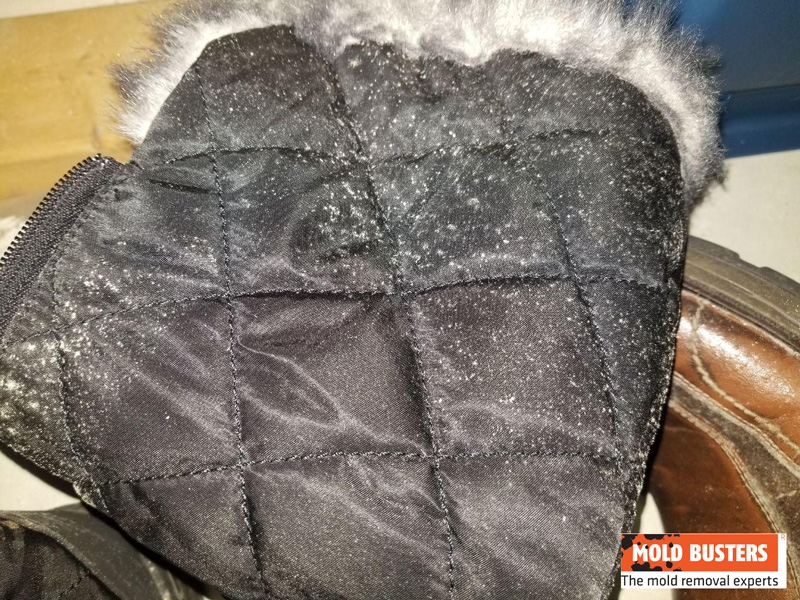
Mold on clothes can also interact with your skin when they come into contact and cause a variety of health problems from skin irritation to full-blown allergies.
Mold is a problem you should not be overlooking especially if you have mold on your clothes. There are steps you can take to learn about mold on clothes, and how to remedy it. Here’s everything you need to know.
Worried About Mold on Clothes? Get a Free Inspection!
Mold on clothes can be a hidden hazard, causing health issues and damage to your belongings. Don’t let it go unchecked! Contact Mold Busters for a free virtual mold inspection. Our experts are ready to provide you with a comprehensive assessment and a plan to tackle any mold issue, ensuring your home and belongings are safe. Act now to protect your health and property!
What is mold on clothes?

Mold is a fungus and an essential component of the eco-system, helping to break down dead trees and leaves, in order for more foliage to flourish in its place. Mold is attracted to damp spaces that naturally occur in nature, but can grow in more unlikely places, like the interiors of homes and apartments and on clothes, if the conditions are just right.
Mold tends to grow in a variety of colours – purple, orange, green, black, or white – on a variety of surfaces depending on the conditions. Mold on clothes is usually the Aspergillus strain, and has a different look and feel to the mold that grows on walls or floors.
Unlike other damp surfaces, mold on clothes often looks white, and sometimes greenish-black. If you have ever seen fungus grow on a piece of bread or cheese, you may be able to recognise when there is mold on your clothes as the appearance is largely similar.
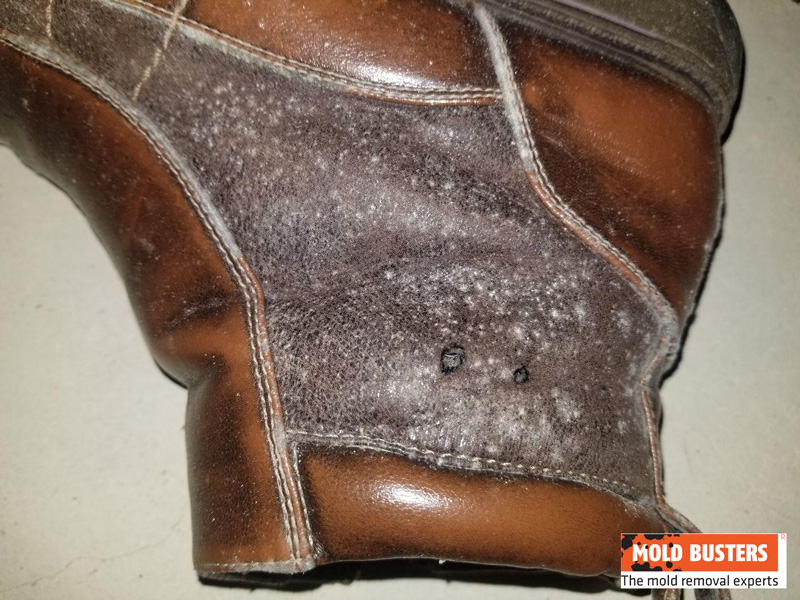
Why does mold grow on clothes?
Similar to the reasons why mold appears in your home, mold on clothes can grow because of dampness and lack of ventilation. Mold disperses spores and toxins that travel through the air and are attracted to damp materials that are fibre-rich, such as wood, drywall, and fabric.
Can clothes get moldy?
Yes, clothes can definitely get moldy. This usually happens when they are left damp for too long, or when they are stored in a humid and poorly ventilated area. It’s important to dry clothes thoroughly before storing them, and to keep your storage areas dry and well-ventilated to prevent mold growth.
How long does it take for mold to grow on wet clothes?
If your clothes remain wet for an extended period of time, mold will be attracted to it fairly quickly – anywhere between 24-48 hours. Keeping wet or even moist clothes in unventilated areas or closely together becomes a breeding ground to grow mold on clothes.
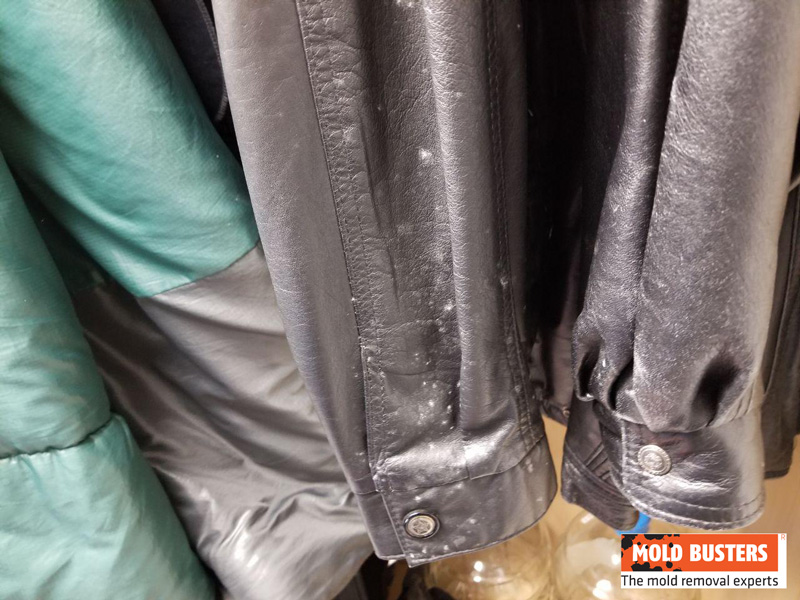
If you have recently washed your clothes, it is always best to dry the clothes in sunlight as soon as possible. If you do not have a way to dry clothes outside, dry them in the dryer. Do not let the clothes remain in the washing machine in their damp state for too long.
What causes mold on clothes?
Mold on clothes is usually caused by dampness and lack of ventilation. Clothes left wet for too long, or clothes stored in a damp and poorly ventilated area, can become a breeding ground for mold. Other factors like residual dirt and body oils on clothes can also contribute to mold growth.
Types of mold on clothes
There are two major types of mold – black mold and white mold. Black mold on clothes is not as commonly seen as white mold on clothes, but there are chances of both occurring under the right circumstances.
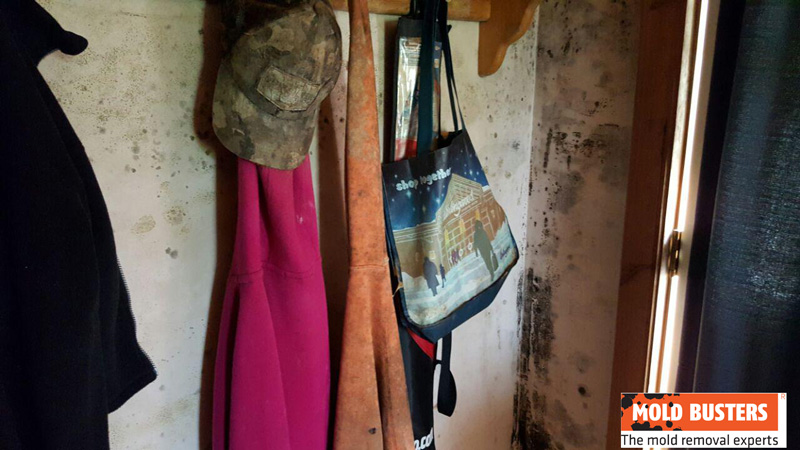
Black mold on clothes
Black mold, also known as Stachybotrys chartarum, is an extremely toxic mold that grows in homes and produces mycotoxins that are capable of causing health hazards in humans, especially once its spores become airborne. By the time black mold is detected, it is often already a major problem in the home.
White mold on clothes
Though not as frequently perceived as a threat, white mold is fairly common in homes. It is harder to detect on lighter surfaces and has a propensity for changing colour. White mold also feels flaky, and has a powdery appearance, very similar to mildew, which is an earlier www of mold.
White mold can be injurious to your health, though not to the same extent as black mold. Both black mold and white mold on clothes are dangerous, causing lasting damage to the surfaces they come in contact with, and must be treated as soon as they are recognised.

Did you know?
Penicillium / Aspergillus group (white mold) is the most common toxic mold type found in homes we tested?! Find out more exciting mold stats and facts inside our mold statistics page.
Brown mold on clothes
Brown mold on clothes can appear as brown spots or patches. Like other types of mold, it thrives in damp, humid conditions and can damage clothes if not removed. Brown mold is not as common as black or white mold, but it should still be taken seriously due to potential health risks.
How to identify mold on clothes?
Mold on clothes can generally be identified by its smell. If you have a mold problem in your house, or specifically on your clothes, you will be able to identify it from its strong musty, earthy odour.
What does mold on clothes look like?
Mold on clothes can appear as spots or patches of discoloration, usually white or green but can be other colors as well. It often has a fuzzy texture and may have a musty smell. If left unchecked, these spots can grow larger and the clothes may take on a permanently musty smell.
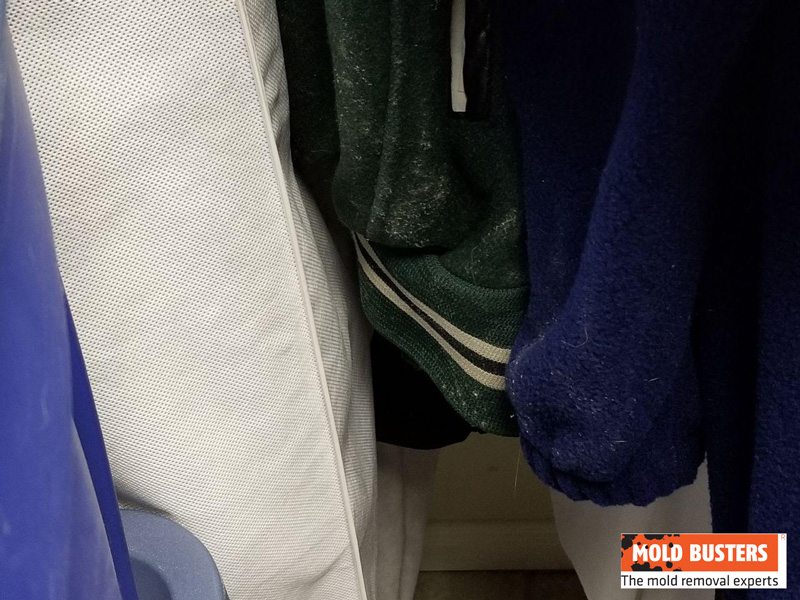
But the mold you see may not be the cause of the problem in your home. Visible mold is usually a sign of a longstanding, undetected mold problem. You need to get to the source of the mold growth or the mold will keep reoccurring.
Identifying the original source of the mold in your home is not something you can do yourself. It is important to perform professional air quality testing to remove the mold permanently. Begin the testing process as soon as you suspect a problem.
Mildew vs mold on clothes
Mildew and mold are both types of fungi, but they have some differences. Mildew is usually white or gray and grows on the surface of moist, warm areas. It can appear as a patch of white or gray fuzz on clothes. Mold, on the other hand, can be various colors, including black, green, red or blue, and it may have a fuzzy or slimy texture. Both can grow on clothes under the right conditions and should be removed promptly to prevent damage to the fabric and potential health risks.
How long do mold spores live on clothes?
Mold spores can live on your clothes for a long time. They are resilient and can withstand dry and unfavorable conditions, lying dormant until they find the right conditions to grow – warmth, moisture, and a food source. Regular washing and drying of clothes, preferably in sunlight, can help in killing mold spores and preventing mold growth.
Mold on Baby Clothes
Mold on baby clothes can be particularly concerning due to infants’ sensitive skin and developing immune systems. If you find mold on baby clothes, it’s important to remove it promptly and thoroughly. Always ensure baby clothes are completely dry before storing, and keep storage areas dry and well-ventilated to prevent mold growth.
Mold on Black Clothes
Mold on black clothes can be harder to spot, but it can still damage the fabric and potentially cause health problems. If you notice a musty smell or if the fabric feels damp or has an unusual texture, it’s worth investigating for mold. Remember, mold can be various colors, not just black or white.
Can mold on clothes make you ill?
Mold has dangerous health effects that should not be ignored. Though your body’s reactions to mold depend on the amount of mold growing in your home, and the sensitivity of your current state of health, the presence of mold has long-term adverse health effects.
The Aspergillus species of mold on clothes can easily be inhaled by people and has been known to cause respiratory problems, like coughing, sneezing, wheezing, and even fever. For those who are particularly susceptible, like children, the elderly, or asthmatics, the consequences can be serious.
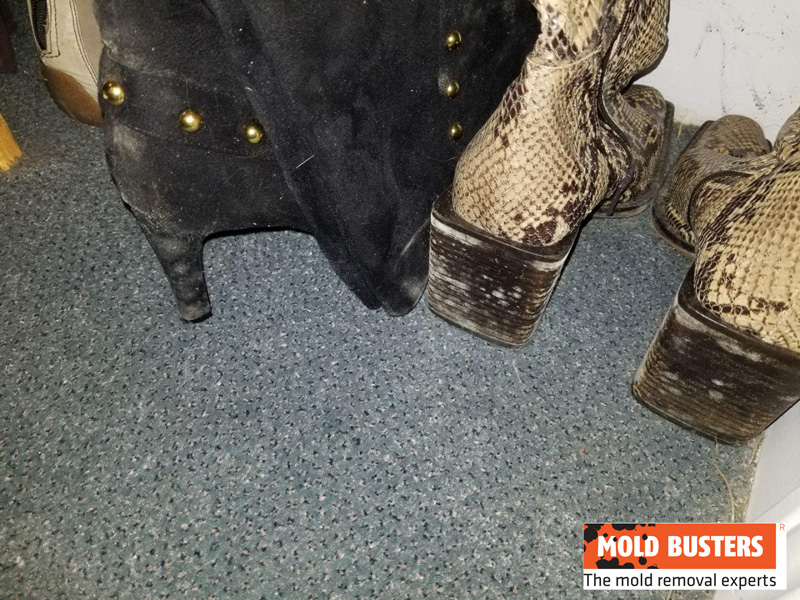
Other types of mold on clothes can cause skin allergies and rashes, if you are particularly sensitive. You can also suffer from fatigue, headaches, and dizziness caused by mold on clothes.
The long-term effects of having mold on clothes, and in your home, can lead to a weakened immune system and recurring ill-health that could indirectly lead to severe infections like tuberculosis, and thus must be remedied as quickly as possible.
Is mold on shoes dangerous?
Mold can grow on shoes, especially if they are stored in damp conditions or if they have been wet and not dried properly. While moldy shoes may not pose as direct a health risk as moldy clothes (as we don’t typically have as much skin contact with our shoes), they can still contribute to poor indoor air quality and should be cleaned or discarded if mold is found.
Is mold on towels dangerous?
Mold on towels can be a health risk, especially if the towels come into contact with the skin or are used near the face. Moldy towels can also be a sign of excess humidity in your bathroom or laundry area. If you find mold on your towels, it’s important to clean them thoroughly and ensure they are dried completely after each use to prevent mold growth.
How can you remove mold from clothes?
There are several DIY solutions for removing mold on clothes that can be accomplished with household products. But be aware that these methods only work on localised mold occurrences.
| Method | Steps | Notes |
|---|---|---|
| Laundry Detergent |
|
Regular detergent can be effective for removing mold stains and smell. |
| Chlorine Bleach |
|
Chlorine bleach can kill mold spores and remove stubborn mold stains. However, it should only be used on colorfast fabrics. |
| Vinegar |
|
Vinegar, with its acetic acid content, can kill mold and remove mold smell. It can also be combined with a few drops of lemon juice for extra cleaning power. |
| Hydrogen Peroxide |
|
Hydrogen peroxide can help remove mold stains and kill mold. However, it can bleach some fabrics, so it’s best to test it on an inconspicuous area first. |
| Air Drying |
|
Air drying can help remove mold smell and prevent the growth of new mold. |
Remember, if mold remains after washing and drying, or if the item has a persistent musty odor, it may be best to discard it. Moldy items can pose a risk of fungal contamination. For delicate or special items, consider professional dry cleaning.
How to get mold out of clothes?
- The combination of baking soda and vinegar has been known to effectively combat mold on clothes. A teaspoon of baking soda with a cup or two of vinegar removes mold and the musty smell. Add this mixture to your washing cycle or soak the clothes in white vinegar for an hour.
- Borax is a mold-killing product and one that is easily accessible even if you don’t already have it in your home. Add a half cup of borax to hot water and wait for it to dissolve before pouring it into your washing machine along with your detergent.
- Alternately, you can use a cup of bleach part way through your washing cycle, but ensure that you check that your clothes do not have a “Do Not Bleach” tag first.
If your mold problem is more widespread, however, these solutions will not be long-lasting. It is highly recommended that you contact a professional mold removal service if you have extensive mold in your home.
Should you throw out moldy clothes?
Deciding whether to throw out moldy clothes can depend on the extent of the mold growth and the value of the clothes. Small amounts of mold can often be removed, but extensive mold growth might be too difficult to clean, especially on delicate fabrics. If the mold has caused persistent stains or the clothes have a lingering musty smell even after cleaning, it might be best to discard them. Remember, health should always be your first priority.
Can you put moldy clothes in the washing machine?
Yes, you can put moldy clothes in the washing machine. However, it’s important to use hot water and a strong detergent to effectively kill the mold spores. Adding a cup of white vinegar or a mold-killing product like borax can also help. Remember to dry the clothes thoroughly after washing to prevent the mold from returning.
How to get mildew smell out of clothes?
The musty smell of mildew on clothes can be quite unpleasant. Here are some steps to help get rid of it:
- Pre-soak the clothes: Soak your clothes in a solution of one cup of white vinegar and a bucket of water. Leave them for a few hours before washing.
- Wash the clothes: Wash your clothes in the washing machine using hot water and a strong detergent. You can also add a cup of baking soda to the wash cycle for extra odor-fighting power.
- Dry the clothes: Dry your clothes thoroughly after washing. If possible, dry them outside in the sunlight, as the sun’s ultraviolet rays can help kill any remaining mold spores and remove odors.
Remember, if the mildew smell persists after washing and drying, it’s best to repeat the process. If the smell still remains, the clothes may need to be discarded to prevent the spread of mold spores to other clothes.
How to prevent mold growing on clothes?
Prevention is better than cure and when it concerns as invasive a problem as mold, it is best to do everything you can to prevent the spread, or even the occurrence, of mold. For instance, it is important to conduct routine home inspections to ensure mold is not growing in your home.
Another factor that helps grow mold on clothes is increased humidity and dampness. Check your ventilation systems and dehumidifiers to ensure that the humidity in your home remains below 50%, at the very least.
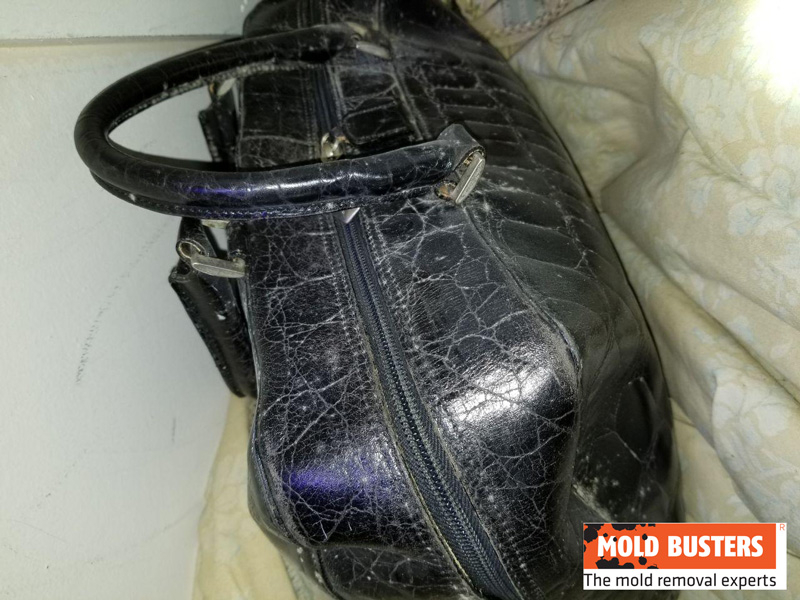
Ventilation in areas that have a high risk of dampness, such as bathrooms and kitchens, should be monitored. If there isn’t enough ventilation in these areas, the situation should be rectified as soon as possible.
Most importantly, when dealing with mold, address the source of the mold problem instead of the symptoms. Mold on clothes, walls, and other surfaces are often the result of a much larger issue like water damage and high humidity, and must be handled accordingly.
FAQ
Is mold on clothes harmful?
The answer to the question of whether or not mold is harmful on clothes depends on the type of clothing and the amount of mold that has formed.
A lot of clothing is made out of synthetic fabrics, which cannot support mold growth. These fabrics include nylon, acrylic, and polyester. In this case, the presence of mold will not have any ill effects on your health. However, if you have a garment made out of cotton or wool, then it may be more problematic.
The real danger from moldy clothes comes from breathing in spores from the fungus as well as touching your skin with wet hands. This can lead to health problems such as allergic reactions or rashes or infections for those who are prone to them (which includes asthma).
How fast does mold grow on clothes?
Mold can grow on clothes in as little as 48 hours. The speed at which the mold grows depends on how warm the area is where they’re stored and how much moisture is present in that space. If you notice some mildew developing on your clothes after only a few days, then there’s likely something wrong with either their storage conditions or their cleaning routine.
The growth of mold is dependent on the type of clothes, how much light they get, and how often they’re washed. For example, cotton t-shirts are more prone to mold growth than wool sweaters because cotton is more absorbent and can retain water for longer periods of time. Also, cotton is typically more often worn than wool (as it’s lighter), so it’s more likely that the moisture from sweat will stay on the fabric longer if you wear a cotton t-shirt every day.
Is black mold on towels dangerous?
Black mold on towels is dangerous. The black color of the mold is a sign that it has been feeding on your towels, which can cause health problems if you continue to use them. You should always check your towels carefully before using them because they may have small spots of black mold growing on them already.
Conclusion
To avoid getting mold on clothes, it is best to store them in cool and dry areas where clothes will not be affected by imbalances in humidity or lack of ventilation. If you’re unsure about the condition of your home or workplace, consider a virtual inspection to assess the situation. Mold has the potential to destroy the surfaces it comes in contact with and, if left unchecked, will eat away at clothes and shoes.
Additionally, mold affects the health of those surrounded by it, causing skin irritation, rashes, and many more problems that have a long-lasting and detrimental impact on your immune system.
Remember that finding mold on clothes is only a symptom of a larger mold issue that is occurring in your home. Mold only becomes visible when it has spread around your home. If you’re in the Montreal or Ottawa area, getting a professional mold inspection done as soon as possible is crucial so a team of experts can begin the process of mold removal.
To check whether you have a mold problem in your home, get a professional mold inspection done as soon as possible so a team of experts can begin the process of mold removal. To learn everything about mold and its prevention, we are here to help.
To remove mold from your home, call Mold Busters today.
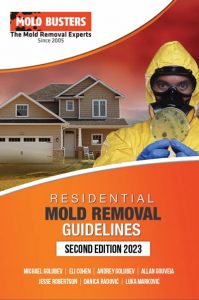
Get Special Gift: Industry-Standard Mold Removal Guidelines
Download the industry-standard guidelines that Mold Busters use in their own mold removal services, including news, tips and special offers:
"*" indicates required fields
Published: May 19, 2020 Updated: May 22, 2024

Written by:
John Ward
Account Executive
Mold Busters
Fact checked by:
Michael Golubev
CEO
Mold Busters
